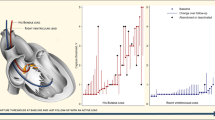Abstract
Nonadequate arrhythmia detection and delivery of electrical therapy is still a main problem in current implantable cardioverter defibrillator therapy. Besides supraventricular arrhythmias extra-cardiac biosignals also can cause inadequate shock delivery. The present study focuses on nonadequate arrhythmia detection due to oversensing of diaphragmatic myopotentials. Their clinical characteristics, incidence and management are presented. Three-hundred-eighty-four recipients of a transvenous cardioverter-defibrillator who were implanted and followed-up at our institution between October 1991 and June 1999 were enrolled. During a mean follow-up of 32±25 months a total number of 139 nonadequate episodes of arrhythmia detection due to oversensing of diaphragmatic myopotentials were observed in 33 patients (8.6%). In 11 patients a total of 32 high energy shock deliveries occurred. Oversensing of diaphragmatic myopotentials was primarily observed in patients implanted with defibrillator leads providing “integrated bipolar” sensing. The vast majority of nonadequate arrhythmia detection were observed during intrinsic bradycardia heart rate and/or antibradycardia pacing. Electrical lead failure was ruled out in every patient. In 90% of the patients with a cardioverter-defibrillator providing programmable maximal sensitivity (n=16), the reduction of maximum sensitivity was effective in preventing further episodes of nonadequate arrhythmia detection. In 48% of the patients with devices without programmable maximal sensitivity (n=17), surgery revision was necessary to solve the problem.
Similar content being viewed by others
References
Berger R, Jacobs W. Myopotential inhibition of demand pacemaker: etiologic, diagnostic, and therapeutic considerations. PACE 1979;2:596-602.
Fetter J, Bodeldyk GL, Engman FJ. The clinical incidence and significance of myopotential sensing with unipolar pacemakers. PACE 1984;7:871-881.
El Gamal M, van Gelder B. Suppression of an external demand pacemaker by diaphragmatic myopotentials: A sign of electrode perforation? PACE 1979;2:191-195.
Barold SS, Ong LS, Falkoff MD, et al. Inhibition of bipolar demand pacemaker by diaphragmatic myopotentials. Circulation 1977;56:679-683.
Singer I, Adams L, Austin E. Potential hazards of fixed gain sensitivity and tachyarrhythmia detection algorithm for implantable cardioverter/defibrillators. PACE 1993;16:1070-1079.
Olson WA. Tachyarrhythmia sensing and detection. In: Singer I, ed. Implantable Cardioverter-Defibrillator. Armonk, NY: Futura Publishing Company, Inc. 1994:71-107.
Physicians System Manual Ventak AVTM 1996; Guidant Corporation, St. Paul, MN, USA
Physicians Manual Contour MDTM 1997; Ventritex, Inc., Sunnyvale, CA, USA.
Physicians Manual GEM DRTM 1998; Medtronic, St. Paul, MN, USA.
Kelly PA, Mann DE, Damle RS and Reiter MJ. Over-sensing during ventricular pacing in patients with a third generation implantable cardioverter-defibrillator. J Am Coll Cardiol 1994;23:1531-1534.
Rosenthal ME, Paskman C. Noise detection during bradycardia pacing with a hybrid nonthoracotomy implantable cardioverter defibrillator system: incidence and clinical significance. PACE 1998;21:1380-1386.
Sandler MJ, Kutalec SP. Inappropriate discharge by an implantable cardioverter defibrillator: recognition of myopotential sensing using telemetered intracardiac electrograms. PACE 1994;17:665-671.
Peters RW, Cooklin M, Brockman R, Shorofsky SR, Gold MR. Inappropriate shocks from implanted cardioverter defibrillators caused by sensing of diaphragmatic myopotentials. J Interv Card Electrophysiol 1998;2:367-370.
Deshmukh P, Anderson K. Myopotential sensing by a dual chamber implantable cardioverter defibrillator: two case reports. J Cardiovasc Electrophysiol 1998; 9:767-772.
Babuty D, Fauchier L, Cosnay P. Inappropriate shocks delivered by implantable cardiac defibrillators during over-sensing of activity of diaphragmatic muscle. Heart 1999;81:94-96.
Mann DE, Otto L, Kelly PA, Reiter MJ. Effect of sensing system on the incidence of myopotential oversensing during bradycardia pacing in implantable cardioverter-defibrillators. Am J Cardiol 2000;85:1380-1382.
Taskforce for ACC/AHA practice guidelines. ACC/AHA guidelines for implantation of cardiac pace-makers and antiarrhythmic devices. J Am Coll Cardiol 1998;31:1175-1209.
Schulte B, Schwarz T, Sperzel J, et al. Dysfunktionen transvenöser Kardioverter/Defibrillator-Elektrodensysteme: klinische Bedeutung system-integrierter Diagnoseund Messfunktionen-Möglichkeiten einer teilauto-matisierten Systemkontrolle. Z Kardiol 1998;87:630-639.
Physicians System Manual Ventak PRx II, 1994; Guidant Corporation, St. Paul, MN, USA.
Physicians System Manual Ventak MINI I 1996; Guidant Corporation, St. Paul, MN, USA.
Schulte B, Sperzel J, Schwarz T, Pitschner HF, Strupp G, Neuzner J. Detection of ventricular fibrillation in implantable defibrillators with automatic gain control amplifiers, effects of programming sensitivity. Europace 2000;2:160-162.
Author information
Authors and Affiliations
Rights and permissions
About this article
Cite this article
Schulte, B., Sperzel, J., Carlsson, J. et al. Inappropriate Arrhythmia Detection in Implantable Defibrillator Therapy due to Oversensing of Diaphragmatic Myopotentials. J Interv Card Electrophysiol 5, 487–493 (2001). https://doi.org/10.1023/A:1013214516002
Issue Date:
DOI: https://doi.org/10.1023/A:1013214516002




